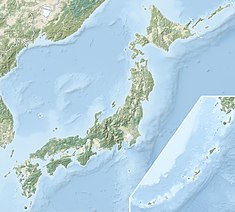
Takikawa is a city located in the Sorachi Subprefecture, Hokkaido, Japan.

Sunagawa is a city located in Sorachi Subprefecture, Hokkaido, Japan.

Fukagawa is a city located in Sorachi Subprefecture, Hokkaido, Japan.

Hydrodamalis is a genus of extinct herbivorous sirenian marine mammals, and included the Steller's sea cow, the Cuesta sea cow, and the Takikawa sea cow. The fossil genus Dusisiren is regarded as the sister taxon of Hydrodamalis: together, the two genera form the dugong subfamily Hydrodamalinae. They were the largest member of the order Sirenia, whose only extant members are the dugong and the manatees. They reached up to 9 metres (30 ft) in length, making the Steller's sea cow among the largest mammals other than whales to have existed in the Holocene epoch. Steller's sea cow was first described by Georg Wilhelm Steller, Cuesta by Daryl Domning, and Takikawa by Hitoshi Furusawa. The Steller's sea cow was the only member of the genus to survive into modern times, and, although had formerly been abundant throughout the North Pacific, by the mid 1700s, its range had been limited to a single, isolated population surrounding the uninhabited Commander Islands. It was hunted for its meat, skin, and fat by fur traders, and was also hunted by aboriginals of the North Pacific coast, leading to its and the genus' extinction 27 years after discovery. The Cuesta sea cow along with the Takikawa sea cow were probably extinct at the end of the Pliocene due to the onset of the Ice Ages and the subsequent recession of seagrasses—their main food source.

Uryū is a town located in Sorachi Subprefecture, Hokkaido, Japan.

Sapporo Station is a railway station in Chūō-ku, Sapporo, Hokkaido, Japan. It is served by Hakodate Main Line and other lines of Hokkaido Railway Company, and is also connected to the Subway Sapporo Station.

Takikawa Station is a railway station in Takikawa, Hokkaido, Japan, operated by the Hokkaido Railway Company.

Nemuro Main Line is a railway line in Hokkaido operated by Hokkaido Railway Company, connecting Takikawa Station in Takikawa and Nemuro Station in Nemuro, including Obihiro and Kushiro. Higashi-Nemuro is the most easterly situated station on the Japanese rail system.
National Route 12 is a Japanese national highway connecting the two largest cities of Hokkaido, Sapporo and Asahikawa. The 135.7-kilometer-long (84.3 mi) highway begins at an intersection with National Routes 36 and 230 in Sapporo. It travels northeast across the western side of Hokkaido to Asahikawa where it ends at an intersection with National Routes 39 and 40.

National Route 38 is a national highway connecting Takikawa and Kushiro in Hokkaidō, Japan.

Higashi-Takikawa Station is a railway station on the Nemuro Main Line of JR Hokkaido located in Takikawa, Hokkaidō, Japan. The station opened on November 10, 1913.

Moshiri Station is an unstaffed railway station in Akabira, Hokkaidō, Japan. It is served by local and rapid trains running on the Furano to Takikawa section of JR Hokkaido's Nemuro Main Line. The station code is T24.

National Route 451 is a national highway of Japan connecting Rumoi, Hokkaido and Takikawa, Hokkaido in Japan, with a total length of 116.5 km (72.39 mi).

Ebeotsu Station is a railway station in Takikawa, Hokkaidō, Japan.

Kami-Atsunai Station was a railway station on the Nemuro Main Line in Urahoro, Hokkaido, Japan, operated by Hokkaido Railway Company. Opened in 1926, it closed in March 2017.
The Hokkaido Chuo Bus Co., Ltd. is a Japanese bus company operating local and long-distance buses in Hokkaido prefecture, Japan. The company operates routes connecting cities within Hokkaido, as well as local city and chartered bus services.
Takikawa Museum of Art and Natural History opened in Takikawa, Hokkaidō, Japan in 1986. The collection includes works by Iwahashi Eien, Ichiki Masumi, and Ueda Sōkyū as well as the fossil type specimen of the Takikawa sea cow, discovered in the bed of the Sorachi River in 1980 and designated a Prefectural Natural Monument.
Takikawa Local History Museum opened in Takikawa, Hokkaidō, Japan in 1977. It is dedicated to the history and ways of life of the area and includes exhibits on Takabatake Toshiyoshi, the Prefectural Cultural Property Documents of the Takikawa tondenhei, and an annex comprising a tondenhei house.
The Takikawa sea cow is an extinct herbivorous marine mammal of the Late Pliocene, which was closely related to the recently extinct Steller's sea cow. In 1988, fossils of sea cows were discovered in Hokkaido, but were originally assigned to the Takikawa sea cow, a newly described species, even though this taxon is thought of by some scientists as a synonym of the Cuesta sea cow. It is uncertain whether or not the Takikawa sea cow was simply a local variant of the Cuesta sea cow or a completely separate lineage. However, Steller's sea cow and the Takikawa sea cow share more morphological similarities than between the Takikawa sea cow and the Cuesta sea cow.
Yōji Takikawa is a Japanese pedagogist, professor at the Center for Educational Research and Development, Tokai University, specializing in science education curricula. In 1986, he organized a circle for practice in science education, which ultimately has developed into a Nonprofit Organization named Garireo-Kōbō with Takikawa being the chairperson of trustees.














